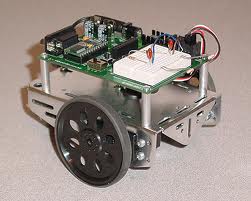The Boe-Bot Robot
THE BOE-BOT

THE BOE-BOT
Robots are taking over the world, and they’re starting in our classrooms!
Or inside our homes, it doesn’t really matter. Robot building using robotic kits is for anyone interested in getting started with robots, electronics, and microcontroller programming, really, with no experience needed. The Boe-bot robotic kit, for example, is widely used in middle and high schools, vocational schools and colleges, as well as by hobbyists and independent learners.
Robots are indeed becoming the more effective alternative to blackboards and notebooks, and the robotics companies know it. Innovative electronics group Parallax, has introduced the Stamps in Class program, which aims to build student’s interest in STEM (Science, Technology, Engineering, Math) topics with engaging, hands-on activities using the BASIC Stamp microcontroller. Specifically, the program introduces microcontroller programming and electronics side-by-side using the BASIC Stamp 2 and Board of Education (clever name, eh?) or HomeWork Board.
The goal of Parallax education, basically, is to provide teachers, students, and engineers the material they need to learn microcontroller programming and interfacing. This is done with a variety of educational texts and kits designed to engage the developer in hands-on learning, starting from circuit design and continuing to advanced robotics.
The Stamps in Class program provides resources for teachers through a private Educator’s Forum and a two-day BASIC Stamp Educator’s Course as support system for new teachers planning to implement robotics in their classroom. One of the most popular robot kits used by students would have to be the Full Kit, which is their most complete reprogrammable robot kit.
This includes online text resources, like the booklet containing 41 possible activities using the this robot with structured PBASIC 2.5 source code support and bonus challenges with solutions in each chapter. Activities start with basic movement and proceeds to sensor-based projects, so customers quickly learn how to expand their robots for several different robotic projects. There are also series tutorials containing sets of hands-on, do-it-yourself activities featuring themes like inventions, robotics, sensors or process control. Again, the best part is that no previous robotics, electronics or programming experience is necessary: Just follow the clear, step-by-step instructions and illustrations with the included book.
Suitable for anybody over 12 years old, the Boe-Bot Robot takes about 1-2 hours to put together, though each project in the Robotics text provides a different experience. It will take about 50 hours to complete the entire set of projects. The Board of Education (and BS2-IC), meanwhile, may also be removed and used as platform for the other kits in the Stamps in Class series. Among other things, learners will be able to write programs in PBASIC on their computers, build simple circuits from schematics and wiring diagrams, download PBASIC programs into the BASIC Stamp to control the circuits, assemble their bot's hardware, learn to drive the robot with simple motion programs and add sensor circuits and program the robot to let it navigate on its own.
In turn, the Boe-bot can navigate by the program commands one gives it, report sensor status with light and sound, escape corners by touch using whisker contact sensors, steer by sensing light to find the brightest or darkest place, detect and avoid obstacles with infrared sensors and detect distance to follow one’s hand or another robot.
Once a learner gets hold of the basics, additional Boe-Bot Robot accessories lets one branch out into new activities, e.g. making the robot talk with a speech board, adding infrared remote control, interfacing direction sensors, and using RF modules and video/camera equipment to build a Video-Bot, among others. The robot’s aluminum chassis is a durable base for the electronics, wheels, and motors, and the slots on its chassis are ready for mounting additional hardware accessories, allowing for easy expansion. The Board of Education breadboard and servo motor ports also allows one to plug in common electronic components with no soldering needed. The robotic kit is priced at $159.99 while the robot's accessories are all sold separately.
Let the invasion begin!